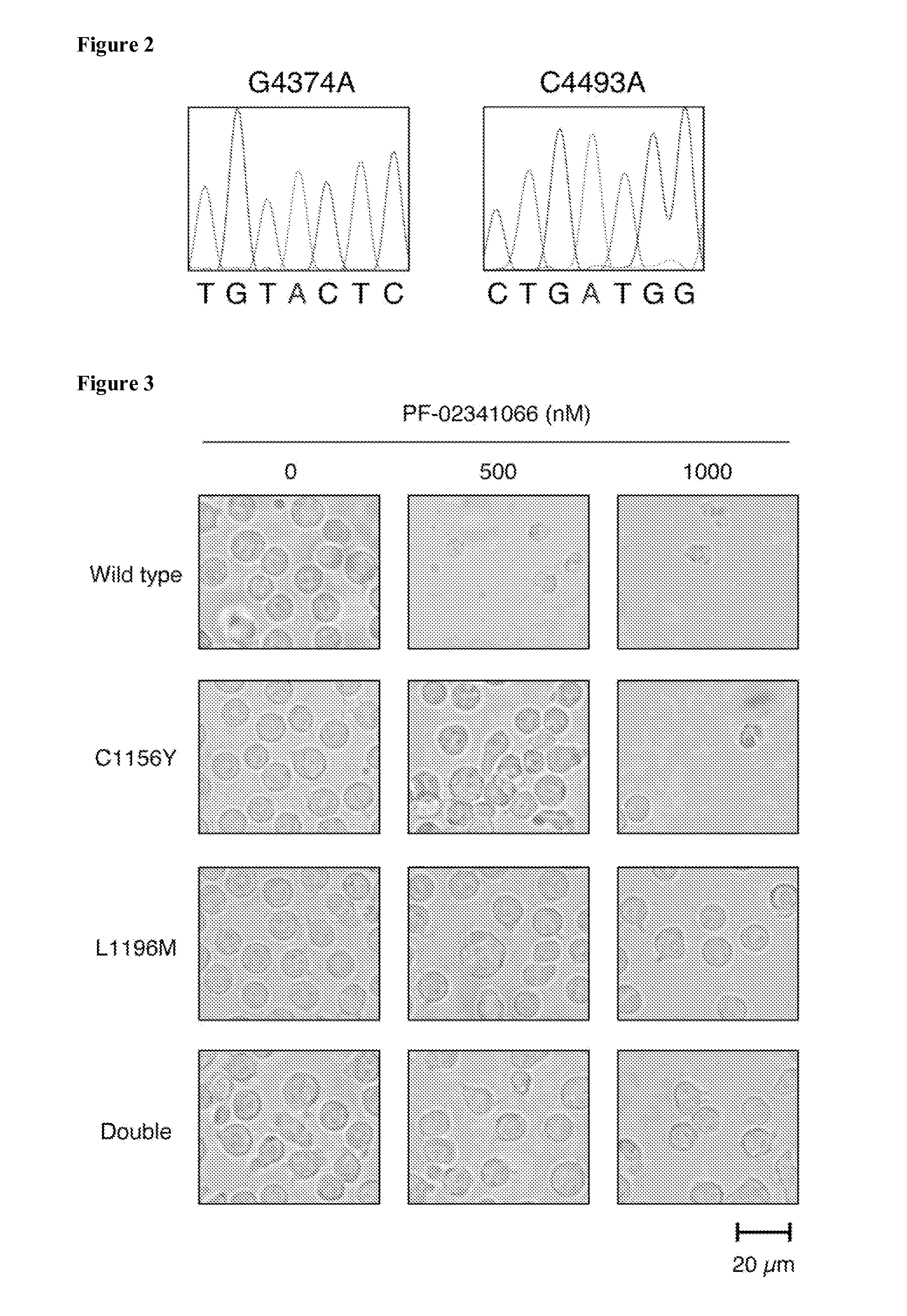Identification, assessment, and therapy of cancers with innate or acquired resistance to ALK inhibitors
a technology of alk inhibitors, applied in the field of identification, assessment, and treatment of cancers with innate or acquired resistance to alk inhibitors, can solve problems such as treatment failure, and achieve the effects of increasing the risk of unresponsiveness to treatmen
- Summary
- Abstract
- Description
- Claims
- Application Information
AI Technical Summary
Benefits of technology
Problems solved by technology
Method used
Image
Examples
example 1
Materials and Methods for Examples 2-4
a. DNA Sequencing
[0246]Oligo(dT)-primed cDNAs were generated from specimen RNAs extracted with the use of the EZ1 system (Qiagen, Valencia, Calif.) and were subjected to the polymerase chain reaction (PCR) of 30 cycles (consisting of 98° C. for 10 s and 68° C. for 1 min) with PrimeSTAR HS DNA polymerase (Takara Bio Inc., Shiga, Japan) and the primers ALK-TK-F (5′-TACAACCCCAACTACTGCTTTGCT-3′) and ALK-TK-R1 (5′-AGGCACTTTCTCTTCCTCTTCCAC-3′). The PCR products corresponding to the kinase domain of ALK were then fragmented and sequenced with an Illumina Genome Analyzer II (GAII) for 76 bases from both ends by the paired-end sequencing system (Illumina, San Diego, Calif.). Raw read data were quality-filtered on the basis of the presence of the PCR primer sequences and a Q value of ≧20 for all bases. The filter-passed reads were then aligned to the ALK cDNA sequence with the use of the Bowtie algorithm (available on the world wide web at bowtie-bio.sour...
example 2
Novel ALK Mutations Associated with Resistance to ALK Tyrosine Kinase Inhibitors
[0250]The patient was a 28-year-old man without a history of smoking, and was diagnosed with lung adenocarcinoma at a clinical stage of T4N3M1 in April 2008. Given that the tumor did not harbor any EGFR mutations, the patient was treated by conventional chemotherapy, which resulted in disease progression with the formation of multiple metastases in the brain and bone. In November 2008, the presence of mRNA for EML4-ALK variant 1 in the tumor was confirmed by reverse transcription-PCR analysis of sputum as well as by fluorescence in situ hybridization analysis of a biopsy specimen. The patient was thus enrolled in a trial of PF-02341066 and experienced a marked improvement in his performance status (reduction from level 4 to 2). Although he showed a “partial response” to the treatment, his pleural effusion was not totally eradicated. After 5 months of treatment, however, the tumor abruptly started to grow...
example 3
Novel ALK Mutations Confer Resistance to ALK Tyrosine Kinase Inhibitors
[0256]It was next examined whether such amino acid changes affect the sensitivity of EML4-ALK to ALK inhibitors. Wild-type EML4-ALK, the single mutants EML4-ALK(C1156Y) and EML4-ALK(L1196M), and the double mutant EML4-ALK(C1156Y / L1196M) were expressed individually in BA / F3 cells, and the cells were then exposed to ALK inhibitors. PF-02341066 inhibited in a concentration-dependent manner the growth of BA / F3 cells expressing wild-type EML4-ALK (FIG. 4A). In contrast, cells expressing either C1156Y or L1196M mutants manifested a markedly reduced sensitivity to this drug, with repeated experiments showing that BA / F3 cells expressing EML4-ALK(L1196M) were more resistant to PF-02341066 than were those expressing EML4-ALK(C1156Y) (FIG. 3). The presence of both mutations did not result in an additive effect on the resistance of cells to PF-02341066. These data thus showed that C1156Y and L1196M mutations each confer resi...
PUM
| Property | Measurement | Unit |
|---|---|---|
| molecular weight | aaaaa | aaaaa |
| pH | aaaaa | aaaaa |
| temperatures | aaaaa | aaaaa |
Abstract
Description
Claims
Application Information
 Login to View More
Login to View More - R&D Engineer
- R&D Manager
- IP Professional
- Industry Leading Data Capabilities
- Powerful AI technology
- Patent DNA Extraction
Browse by: Latest US Patents, China's latest patents, Technical Efficacy Thesaurus, Application Domain, Technology Topic, Popular Technical Reports.
© 2024 PatSnap. All rights reserved.Legal|Privacy policy|Modern Slavery Act Transparency Statement|Sitemap|About US| Contact US: help@patsnap.com










